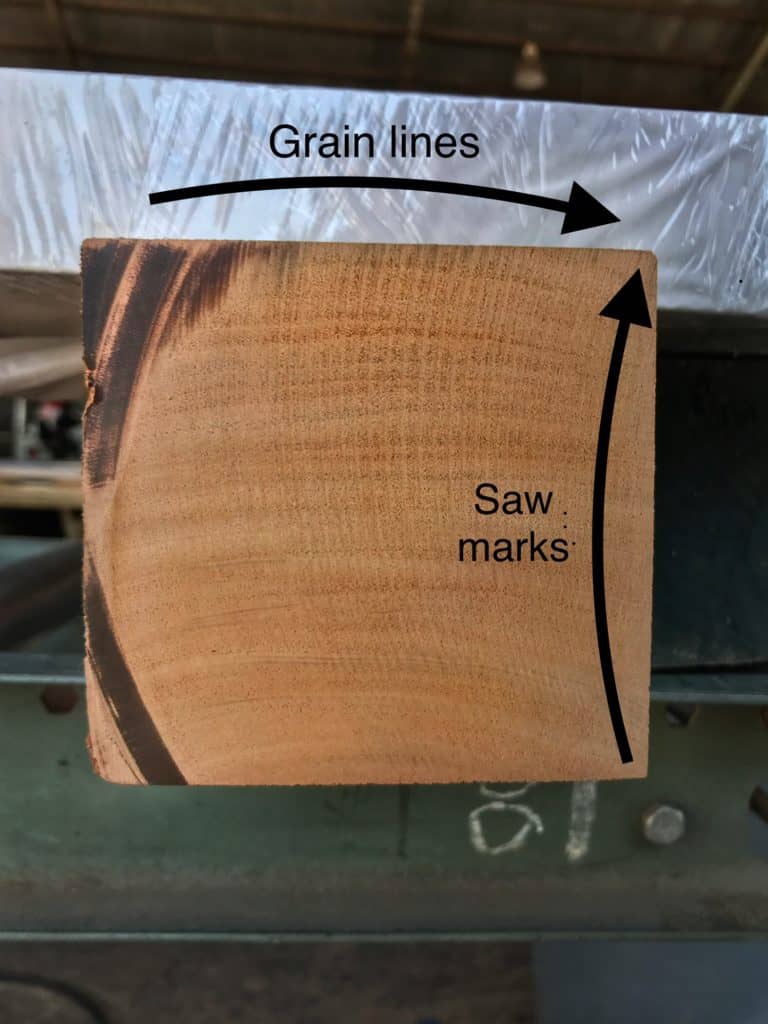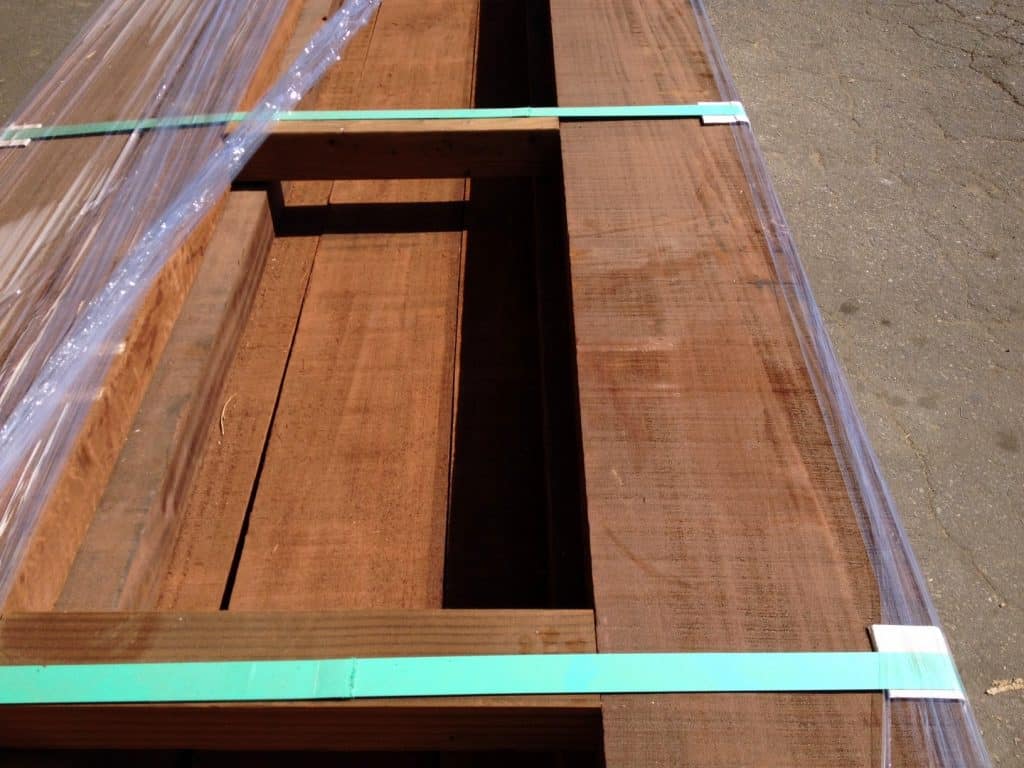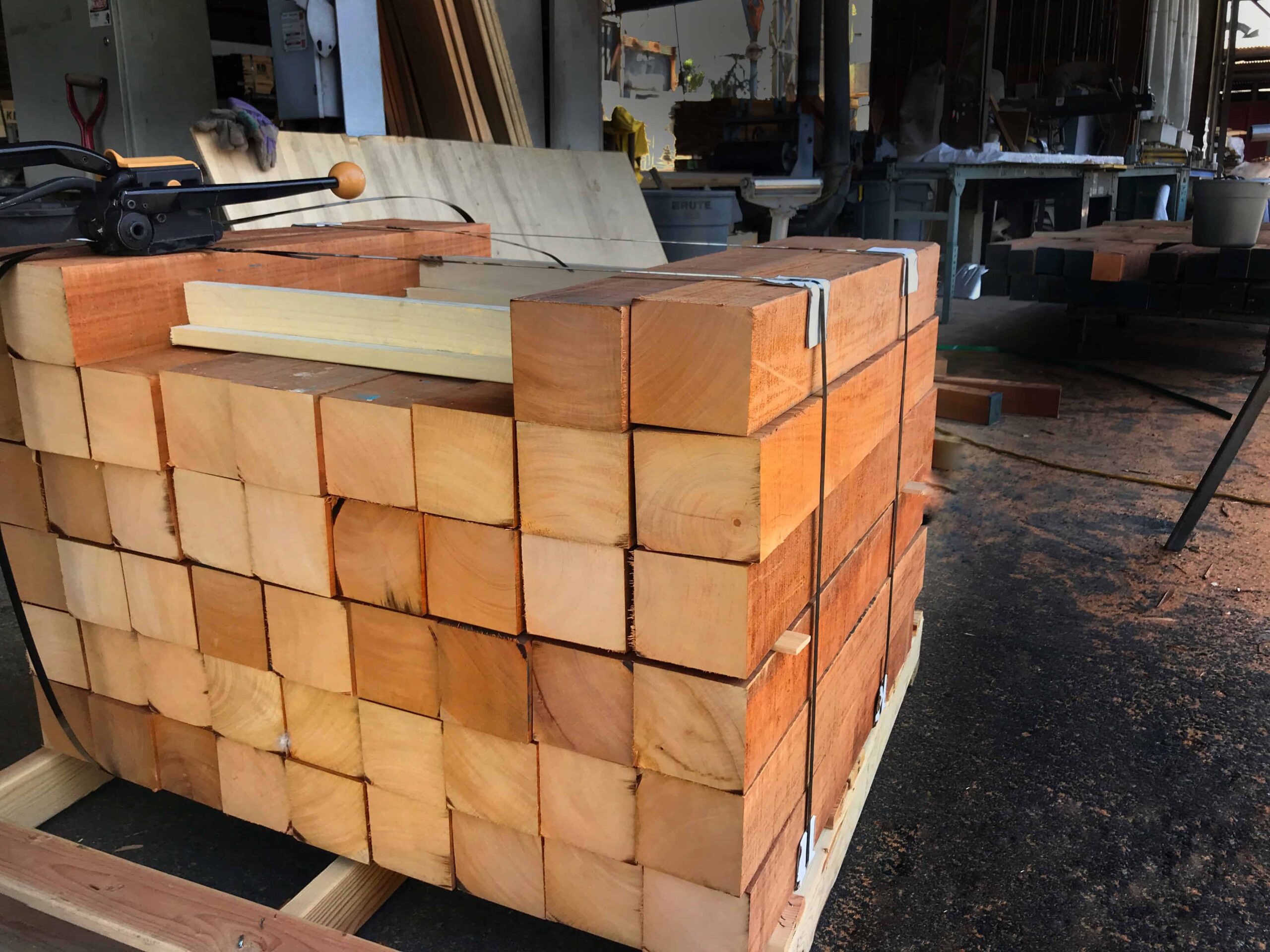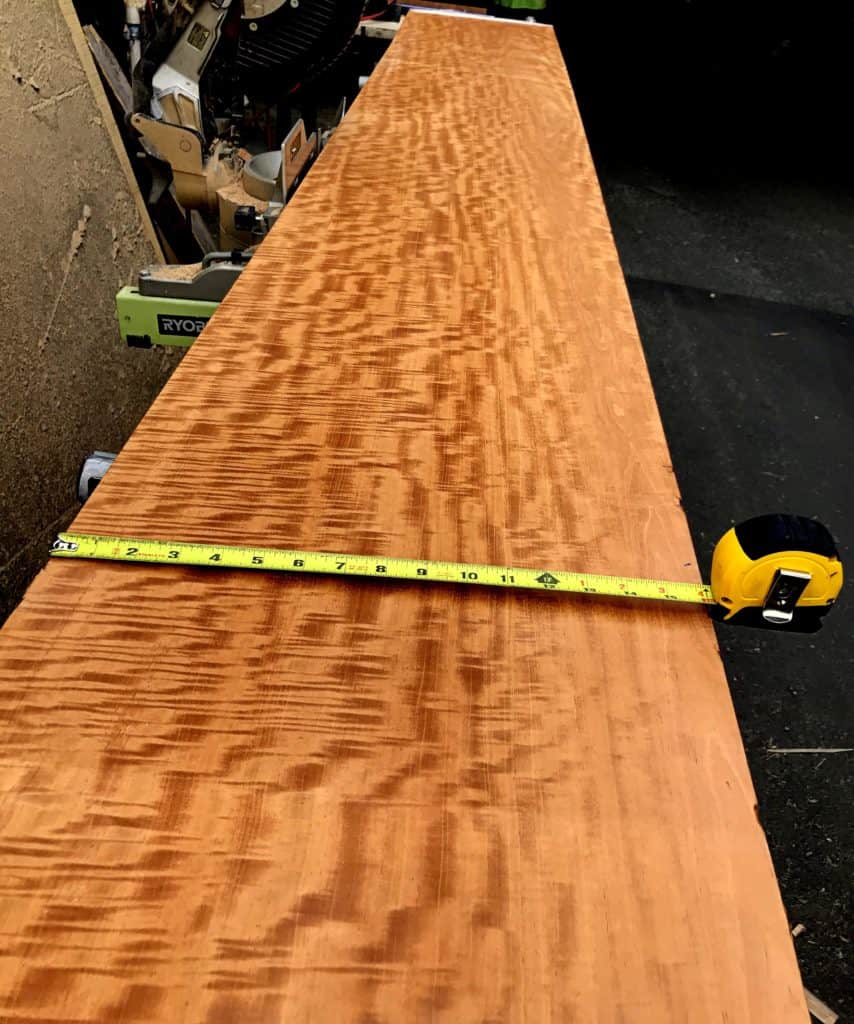Genuine Mahogany Lumber: What is it?
Genuine Mahogany lumber or Swietenia macrophylla (also called Honduras or Honduran mahogany) is the specie of choice for millwork, wood furniture, ship interiors and musical instrument tonewood.
Key Takeaways:
- Woodworkers often consider Genuine Mahogany the one true mahogany.
- Gibson Guitars use Genuine Mahogany for the bulk of their American-made guitar bodies.
- Genuine Mahogany machines cleaner and smoother than mahogany substitutes like Okoume, Khaya and Meranti. Accordingly, it has less grain tear out when milled by hand or machine tooling.
- Unlike African, Honduras Mahogany, Genuine Mahogany lumber has a consistent texture and low silca content. This means it mills longer without dulling toolblades.
Genuine Mahogany Lumber Data
| Scientific Name | Swietenia Macrophylla |
|---|---|
| Common Names | Big Leaf Mahogany, Honduran Mahogany, Honduras Mahogany, Real Mahogany, South American Mahogany, True Mahogany |
| Family | Meliaceae |
| Genus | Swietenia |
| Higher Classification | Oleeae |
| Rank | Species |
| Kingdom | PLantae |
| Region of Origin | Central America, North America, South America |
| CITES Appendix | Yes |
| IUCN Red List of Concern | Yes |
| Durability | High |
| Density | Medium |
| Janka Rating | 800 |
| Scent | Sweet, Yes |
| Average Weight (LB) per Board Foot (KD) | 3.0 |
| Average Board Width (inches) | 7.5 |
| Average Board Length (feet) | 10 |
| Average Tree Diameter (inches) | 55 |
| Average Tree Height (feet) | 180 |
| Texture | Medium, Uniform |
| Heartwood Color | Brown, Red |
| Sapwood Color | Brown, Red |
| Grain Type | Fine, Normal, Slight, Uniform |
| Heart/Sap Distinction | Strong, Weak |
| Drying Difficulty | High, Medium, Prone to sap stain |
| Commercial Availability in US | Low, Medium |
| Cutting Ease | High, Machines well, Medium |
| Glue Difficulty | Adheres well, Low |
| Color Tone | Brown |
| Stability | High |
| Finish Difficulty | Low |
| Thickness Availability | 10/4, 12/4, 16/4, 4/4, 5/4, 6/4, 8/4 |
| Plain Sawn Availability | Yes |
| Quartersawn Availability | Yes |
| Live Sawn Availability | Yes |
| Veneer Availability | Yes |
| Grades Available | #1 Common, #2 Common, FAS, Select |
| Milling Available | Edge Glue, Gang Rip, Rough-sawn, S2S, SL1E, SL2E |
| Millwork Wood | Yes |
| Birdseye Figure | No |
| Curl Figure | Rare, Yes |
| Quilt Figure | Rare, Yes |
| Flame Figure | Rare, Yes |
| Furniture Wood | Yes |
| Turning Wood | Yes |
| Flooring Wood | Yes |
| Guitar Wood (Acoustic) | Yes |
| Guitar Wood (Electric) | Yes |
| Price | $$$ |
| Similar Species | African Mahogany, Sapele, Spanish Cedar |
↓ Subscribe for Video Secrets of the Wood Business ↓

Genuine Mahogany Wood Properties
- Scientific name: Swietenia macrophylla
- Alternative Names: Honduras Mahog, Honduran Mahog, Cuban Mahog
- Region of Origin: South America, Central America, North America
- Average Dried Weight: 39.5LB/cubic foot
- Janka Hardness Rating: 800
- Specific Gravity: .595
- Aromatic: Has a spicy-wood smell
- IUCN Red List: Yes
- CITES wood: Yes
Swietenia Macrophylla Producing Region
Mahogany Wood History
Origins
In 1671, the term mahogany was first used in print. Cartographer John Ogilby wrote of mahog in his atlas titled “America.”
At that time, there were no plantations. It grew in native areas only. These areas ranged from Florida to Peru and Brazil. This remained unchanged through most of the 20th century.
African slaves likely coined the term mahogany. They saw mahog trees in the West Indies. Because of the many similarities between African and Honduras, they mistook the new specie for Khaya or m’oganwo, as they referred to it. The similar phonetic sound of mahogany vs. m’oganwo is likely not a coincidence.
New York Times – Arts – “Felling Mahogany in Honduras.”
Although Honduras Mahog is synonymous with wealth and prestige, its early trade is characterized by boom and bust cycles. According to Central Washington University‘s Dr. Craig Stephen Revel‘s doctoral dissertation:
Controversy
Additionally, harvesting was inexorably tied to the slave trade. Thus, the wood was controversial. It was the blood diamond of the late 19th century. In The Lazy Tour of Two Apprentices, Charles Dickens uses mahogany as an allusion to slavery:
Modern Harvest Areas
Most of the Genuine Mahogany Timber (Swietenia macrophylla) now grown comes from plantations where the timber is managed under controlled conditions. They typically operate responsibly and sustain-ably.
Geographically, we are talking about areas in Mexico, Fiji, Costa Rica instead of lush rain forests. The soils in these plantations are different than the old harvest areas. More minerals in the soil = more mineral streaks/color variations. The new plantations also tend to be in faster growing areas which means quicker turn times for getting lumber to market. However, the quality is not the same. Young fast growing trees in a less-than- ideal climate results in wide growth rings, weird colors, pin knots, etc. Thus, plantation grown wood sometimes fails to command premium wood pricing.
Much of the production we’ve seen out of Fiji has at least some of these quality issues. It is the same specie as Genuine (Swietenia macrophylla) but it’s pinkish red color as opposed to dark brown primarily because of where it’s grown. Dark, dense, uniform color mahog can still be found.
Where Does the Best Mahogany Grow?
Here is our answer based on years of lumber buying experience.
For electric guitar bodywood applications, the best geographic region is in Mexico. This is because the rich Mexican soil promotes fast growth and low density wood in a low mineral environment. Additionally, production methods are often sustainable and well monitored. Thus the guitar wood is light weight and consistent color. The result is low weight uniform color guitar bodies.
For millwork and furniture applications, the best region is the central to southern portion of South America. Here, the wood growth is slow and wood tone is dark. Accordingly, the color is rich and consistent. Also, the lumber from this region machines better. This is due to less grain tear out than wood from faster growing regions.
Honduras Mahogany Lumber For Sale in 2022
Unfortunately, many people believe that high quality Genuine Mahogany no longer exists. Current production methods and locations are different than they were 200 years ago. Thus the product is different but not worse, in my opinion.
We supply Honduras/Genuine in quartersawn and plain-sawn grain orientations.
- 4/4 Genuine Mahog
- 5/4 Genuine Mahog
- 6/4 Genuine Mahog
- 8/4 Genuine Mahog
- 16/4 Genuine Mahog
Old Growth Mahogany
There are several ways to acquire high quality Honduran Mahogany lumber:
- Find a way to some harvest prime old-growth wood from restricted forests. * This is not an option for us but unfortunately not everyone shares this morality.
- Track down some of the few remaining Honduran stashes that have been sitting dormant in warehouses for years. Wood people have a tendency to go wood crazy when there is money in the bank and they’ve found something special. I know lumber baron-types who died leaving their estate with 7 figure sums of exotic woods to find homes for. It happens in smaller shops, too. When you suddenly find a rare exotic wood after years of fruitless searching it’s easy to over buy. Who knows when the next opportunity will present itself? Thus, a stash is born.
- The third and best option is to align yourself with plantation producers who understand the quality issues and have controls in place to deal address them.
Why Is Plantation Mahogany Quality Inconsistent?
My theory is that the driving force behind many plantation operations are bean counters rather than lumber people.
Unfortunately,few accountants outside of the industry understand lumber well. Accountants like SKU’s that are cleanly categorized. There are dozens of reasons why a SKU of Honduras may be worth more or less than where an accountant pegs the value. Rather than lumber quality, the focus is too often on cash flow, ROI, inventory turns, political stability, etc. These are important considerations but all Genuine is not good Genuine.
Mahogany In Necks
Mahogany is one of the most common electric guitar and acoustic guitar neck woods. Perhaps second only to maple. Gibson Brands uses mahog necks in most of their guitar builds.

How are Mahogany necks different than Maple necks?
- Appearance. MAH necks have a deep brown/red color tone with pronounced grain lines. Maple necks are typically made of white sapwood. Also, maple grain-lines are slight.
- Density.Generally speaking MAH has a lower density than both sugar maple and soft maple. According to the Cedar Strip Kayak Workshop, maple is approximately 12% more dense than Honduras MAH. However, it combines both hard maple and soft maple into a single merged category. Thus, wood density variation is greater when comparing MAH to hard maple than soft maple.
- Cost. Unfigured FAS grade Genuine MAH lumber costs approximately 200-300% more than Sugar Maple lumber.
- Machining. Honduran MAH is very easy to shape and machine. It is not prone to grain tear-out. Whereas, maple is harder on tooling. Chipping is also more common in maple than mahog. Significantly, Sugar Maple is also commonly referred to as Hard Maple.
- Tone. Among luthiers, MAH is known as a darker and warmer sounding tonewood than maple. Maple has a clean pronounced tone with a strong mids and highs. Maple tone characteristics involve clarity and note separation.



Pingback: The Accountant's Blind Spot - Commercial Forest Products
Pingback: Import Wood End Checking: How to Prevent - Commercial Forest Products
Pingback: 🌳 Pau Ferro: Indian Rosewood Alternative - Commercial Forest Products
Pingback: 🌳 Swamp Ash Wood - Definitive Guide - Commercial Forest Products
Pingback: 🌳 Spanish Cedar for Humidors & Guitars - Commercial Forest Products
Pingback: 🌳 White Limba/Korina: Lumber & Guitars - Commercial Forest Products
Pingback: 🌳 Paulownia - Lumber -Wood - Commercial Forest Products - 2019
Pingback: 🌳 Quartersawn Maple: A Helpful Illustrated Guide to Hardwood - 2019
Pingback: 🌳 Wood Shop - Spring View - Commercial Forest Products- 2019
Pingback: Chatoyancy - What is Chatoyance in Figured Wood? - Commercial Forest Products
Pingback: Chatoyancy - What is Chatoyance in Figured Wood? -
Pingback: ROASTED MAHOGANY WOOD | LUMBER - Commercial Forest Products
Pingback: Wood: What Is It? 2021 - Commercial Forest Products
Pingback: 10 Best Hardwoods For Woodworking By A Hardwood Lumber Pro - Commercial Forest Products
Pingback: What Is Primavera Wood? 2022 - Commercial Forest Products
Pingback: film